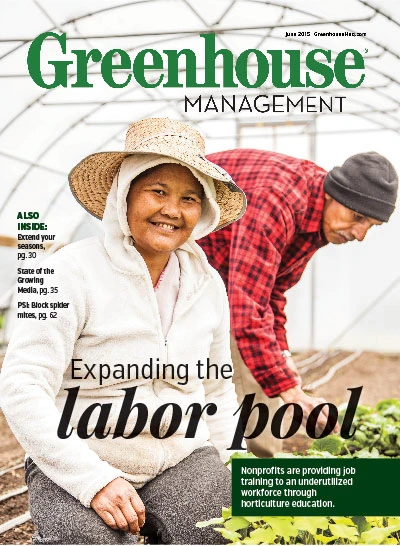Meet the perp
 The Basics: Downy mildews are truly downy, but they aren’t even fourth cousins to powdery mildew. The pathogens are oomycetes (water molds), which makes them relatives of Phytophthora and Pythium. The “downy” part of the name describes the look of the gray or white sporulation on the undersurface of the infected leaves — it looks a little like Botrytis, except that it often appears on still-green tissue.
The Basics: Downy mildews are truly downy, but they aren’t even fourth cousins to powdery mildew. The pathogens are oomycetes (water molds), which makes them relatives of Phytophthora and Pythium. The “downy” part of the name describes the look of the gray or white sporulation on the undersurface of the infected leaves — it looks a little like Botrytis, except that it often appears on still-green tissue.
The victims: Downy mildews bother snapdragons and roses in the greenhouse cut-flower era. Herbaceous perennials have always had their share of downy mildew problems on crops including geum, veronica, coreopsis, rudbeckia, phlox and lamium. Bedding plant growers have seen downy mildew diseases of alyssum, snapdragon, argyranthemum, stock and strawflower — and more recently, new diseases have appeared on coleus, agastache, basil and impatiens. Plants in the same family may share a downy mildew — but note that basil, lamium,and coleus (all mints), have different downy mildews. Spread for some of these diseases is by seed, but in some cases seed transmission is not known. Infected cuttings or plants and the airborne sporangia themselves are the means by which the disease gets around.
Known locations: Downy mildews crave high humidity, and often prefer cooler (spring or fall) conditions. With overhead irrigation and some shading, the impatiens downy mildew is active even in midsummer in the Northeast. Downy mildews can cause systemic infections (involving the whole plant) in addition to causing leaf spots.
 Infection will occur when the plant surface is wet for the requisite number of hours, at an acceptable temperature. Young seedlings are susceptible, as are older plants. Downy mildew often stunts plants severely if they are infected when young, while older plants in some cases develop only leaf lesions. Impatiens walleriana is destroyed by downy mildew at any age.
Infection will occur when the plant surface is wet for the requisite number of hours, at an acceptable temperature. Young seedlings are susceptible, as are older plants. Downy mildew often stunts plants severely if they are infected when young, while older plants in some cases develop only leaf lesions. Impatiens walleriana is destroyed by downy mildew at any age.
Stop and Spot
- Know whether your crop is susceptible to a downy mildew, and learn what the symptoms look like.
- Anticipate trouble in spring and fall, and scout the crop weekly for symptoms.
- Look for angular (vein-bounded) leaf spots colored yellow or brown, or stunted growth at the top of the plant, leaf curling or leaf drop.
- Examine the undersurface of leaf lesions with a microscope or strong hand lens, or send to a diagnostic lab for confirmation that the sporulation of a downy mildew is present.
Prevention
- Keep humidity down in the greenhouse and have good air circulation.
- Use disease resistant cultivars whenever possible.
- Once you have learned that you need to manage a crop for downy mildew disease you may want to treat preventively. (See the chart below for materials.)

Treatment
- If you confirm a downy mildew in your greenhouse, discard the sick plants in plastic bags (try not to dislodge a lot of sporangia in the process) and then treat to protect the rest.
- Downy mildew treatment is best done preventively, once you understand your crop and the time of year it is vulnerable.
- Be sure to rotate chemistries with different modes of action.
- This pathogen is a prolific sporulator, notorious for developing resistance to a fungicide active ingredient that is used repeatedly. So don’t give it a chance: Use some contact materials, and some systemic materials —and two or more active ingredients — in your control scheme.
- You can go by the numbers: FRAC Group 4 (SubdueMAXX); 11 (e.g. Heritage, Compass O, Insignia); 21 (Segway, Ranman), 33 (phosphonates, e.g. Aliette, Alude); 40 (e.g. Micora, Stature, Orvego, Revus); 43 (Adorn) plus mancozeb or copper contact materials are some of the most helpful fungicides to protect against downy mildew (see labels for which crops may be treated and details regarding tank mixing or rotation requirements).
Margery Daughtrey is a plant pathologist specializing in ornamentals at Cornell’s Long Island Horticultural Research & Extension Center. She aims to help growers outwit diseases.

Explore the June 2015 Issue
Check out more from this issue and find your next story to read.
Latest from Greenhouse Management
- 2025 Proven Winners Horticulture Scholarship applications now open
- How to improve inventory and shipping management in the greenhouse
- Leading Women of Horticulture: Anna Ball, Ball Hort, and Terri McEnaney, Bailey Nurseries
- GM CEA HERB Part 2: A guide to increasing the sowing density of culinary herbs
- GM CEA HERB Part 1: Best practices for producing culinary herbs in controlled environments
- USDA fires experts on invasive pests, including Asian citrus psyllid, chilli thrips
- CEA Alliance celebrates bipartisan introduction of Supporting Innovation in Agriculture Act
- Dümmen Orange North America celebrating 25th anniversary in 2025







